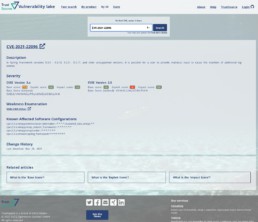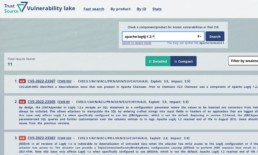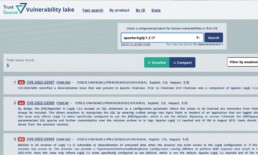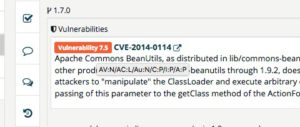Free Vulnerability Lake Search - Better identify potentially vulnerable Components and other Tools
TrustSource Vulnerability Lake Search
Both software developers and security researchers are familiar with the challenge of assigning known vulnerabilities to open source components. Although the CPE (Common Platform Enumeration) codes provide a standardised scheme for associating vulnerabilities, the nomenclature was originally developed for vendor software and only fits poorly in the context of open source components, which often lack a clear “organisation”.
This leads to problems in finding and correctly assigning them. Sometimes the project name wins, e.g. “kubernetes:kubernetes“, other times it is the organising foundation, e.g. “apache:http“. Sometimes projects pass through different organisations over time, like the widely used Spring framework. Then information can be found under “pivotal_software:spring_framework” and from 2019 under “vmware:spring_framework“, which will cause a lot of irritation for years to come due to the concurrency of versions.
And, to top it off, there are even challenges with the project names themselves: “npmjs” or rather “npm_js” or “npmjs:npm”?
TrustSource Vulnerability Lake Search turns the tables: it provides search options to search in the existing CPEs and thus ensures to find the right keys to be considered.
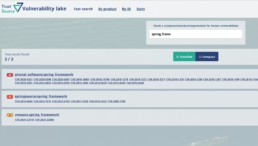
With the help of TrustSource Vulnerability Alert I will catch all Known Vulnerabilities even while asleep!!
TrustSource Vulnerability Alert
With the help of the TrustSource Vulnerability Alert, you can always stay up to date. The identifiers found with the search described above can be subscribed to. Registered users – registration is free and easy, e.g. via a GitHub account – can add selected terms to a list. These lists are checked every few hours against updates from managed sources such as the NVD. If updates or new entries are found, the subscriber receives an email with a link to the new information.
TrustSource customers get this functionality automatically applied to all the bills of materials (SBOMs) in their solution(s). TrustSource-Scanners
determine the SBOMs while your application is being built and therefore know all the dependencies, including the transitive ones. In addition, you can also add infrastructure components to the project in TrustSource itself, and thus identify the vulnerable libraries that do not occur in your own source code.
Vulnerability alerts can be communicated either by email to the relevant project participants or to the system’s own inbox. The latter is especially necessary to avoid failures due to absences or other filters of asynchronous communication.
To enable easy integration into surrounding systems, all these functions are also available via API. However, the use of the API is subject to a fee and is not part of the free plans.
In order to enable a quick classification of the criticality, TrustSource always shows the information on the attack vector as well as the criticality in CVSS values (Common Vulnerability Scoring System, find details on CVSS here) in addition to the description of the CVE or its assignment to the OS components.
TrustSource Life Cycle Alert
These capabilities result in yet another service that TrustSource makes available to its customers: The Life-Cycle Alert.
The obligation of a software manufacturer to inform its customers about known vulnerabilities does not end with the delivery of the software, it usually begins only then. This is even more true for equipment manufacturers. The less possibility there is to motivate the customer for timely updates, the more complex the situation becomes.
If, in the course of time _after_ the release of the software, known vulnerabilities emerge in the components used, it is up to the manufacturer to inform its customers in the sense of proper information provision. This obligation is already applied in the area of medical devices (MDR) and will certainly extend to other areas.
TrustSource makes it possible to record SBOMs that have been released and thus subject them to continuous monitoring. Every patch or release status that has been generated on a customer product can be tracked and alerted accordingly.
It sounds promising but you are not sure whether your specific demand will be met?
Or would you prefer to get hands-on experience in a free trial?
Understanding the most important vulnerability acronyms
Since the Equifax event, vulnerability management gained a lot of attention. But what does "vulnerability" or "known vulnerability" mean? How to handle such an information? And why is this particular important to open source components?
To answer all these questions, we will publish a short series of articles. First we will dive into the goals of vulnerability management and basic concepts. Then we point our attention to the process of vulnerability management and finally show, how TrustSource may support you in performing these tasks.

The goal of vulnerability management
The goal of vulnerability management should be to MINIMIZE THE POSSIBLE ATTACK SURFACE of your environment, where "the environment" may be any scope of software you define (a SaaS, a software package or a complete enterprise). Minimizing the attack surface on the one hand means to accept that there will remain a risk. On the other hand, it means to know all possible attack vectors, assess the risk (maximal loss) associated and derive measures well suited to reduce the attack surface to a financially acceptable risk. This said, it is absolutely essential to assess your environment applying the most recent knowledge - known vulnerabilities - and to address all critical aspects.
The acronyms and concepts
This goal sounds ambitious. But no panic! tehre are some concepts out there helping you to do the job. Before we step into the process, we advise to familiarize with the following few abbreviations , terms and concepts:
-
CVSS = Common Vulnerability Scoring System
has been introduced to measure the impact of a vulnerability. Has a scale of 0-10, with 10 the highest, most critical. Everything above 7.5 may be considered as critical. CVSS is currently in v3, however, vulnerabilities reported prior to 2016 will have been reported in CVSS v2.
-
CAV = Common Attack Vector
describes the identified attack covering aspects such as prerequisites to execute the attack, impact and effect the attack will have. in v3 this will be attach vector (AV), attack complexity (AC), priviledges required (PR) and UI (User interaction). In version 2 (pictured in the tool tip on the right) you will see attack vector (AV), access complexity (AC), Authentication (Au), as well as the impacts on Confidentiality (C), Integrity(I) and Availability (A).
The standardized description of the attack vector is a great help when it comes to understand the impact a potential threat or a vulnerability may have.
-
CVE = Common Vulnerability and Exposure
The CVE is a key identifying a particular vulnerability. The key consists of the three letters CVE, the year and a counter. The counter is assigned by an assigning authority. The counter has no other meaning than to differentiate the particular vulnerability and exposure entries. It gets assigned in the moment it is requested. To request a number, no evidence is required. However, between assignment of an ID and its confirmation several weeks or months may pass.
-
CPE = Common Platform Enumeration
To provide a sound capability to match a vulnerability with the components concerned, the CPE has been introduced. Each component that has a vulnerability assigned, receives a CPE - currently following specification v2.3. A CPE is a unique identifier of a product allowing to refer back from the vulnerability to the product. The CPE (v2.3) consists of a type (h=hardware, o = Operating system, a = application), vendor, product and version information. A central directory, the CPE-dictionary contains all CPEs ever assigned.
However, the matching of CVEs with its assigned CPEs to real life components is critical. Wrong matches lead to false positives, putting the cat under the pigeons; missing matches leave vulnerabilities untreated. That is why we do spend so much attention on accuracy here.
-
CWE = Common Weakness Enumeration
This is a list of weaknesses found in applications. It is a community approach led by MITRE and SANS Institute, supported by huge number of technology heavy weights listing all kind of weaknesses, outlining their inner workings, exploit code and more details. CVEs may have a link to the corresponding weaknesses. the list is a great resource for security experts as well as wanna-be-hackers. It helps to understand the way attacks are created as well as what causes attacks to be successful.
The information supports the understanding of the impact a vulnerability really may have on the individual application.
So what?
Having read all this, you may want to turn your back at the topic and say, "Well, sounds good. Seems like all settled. Why bother?". Yes, there is a lot of structural work that has been done. But it these structures have only been created to allow you doing the job efficiently. The job still needs to be done. In our next post on vulnerabilities, we will cover the process on how to really assess a vulnerability and derive useful action.

